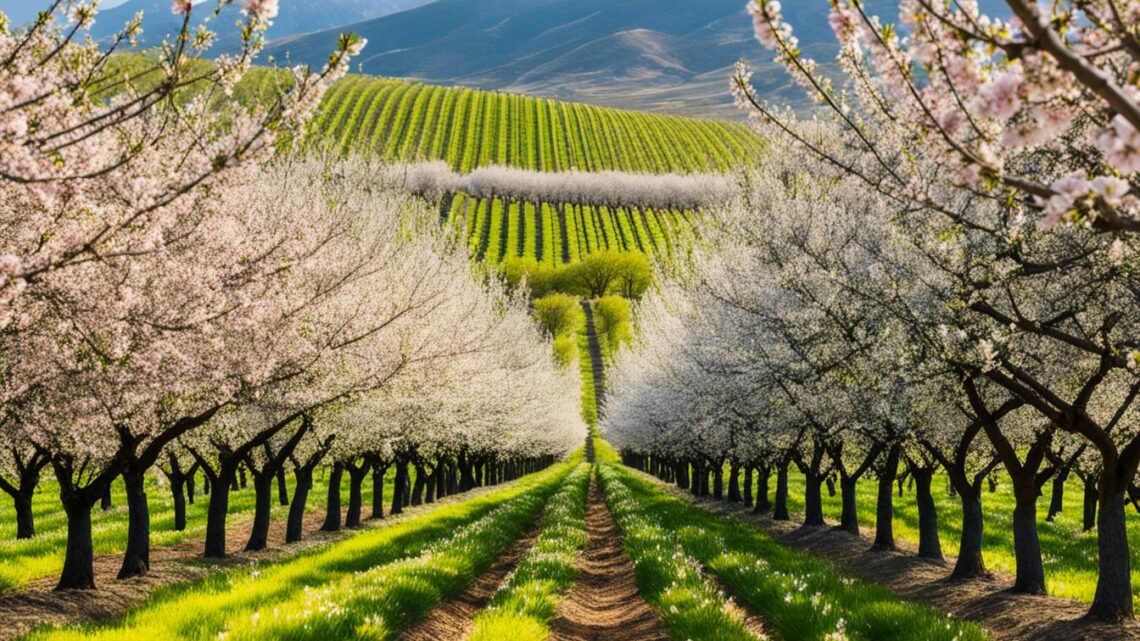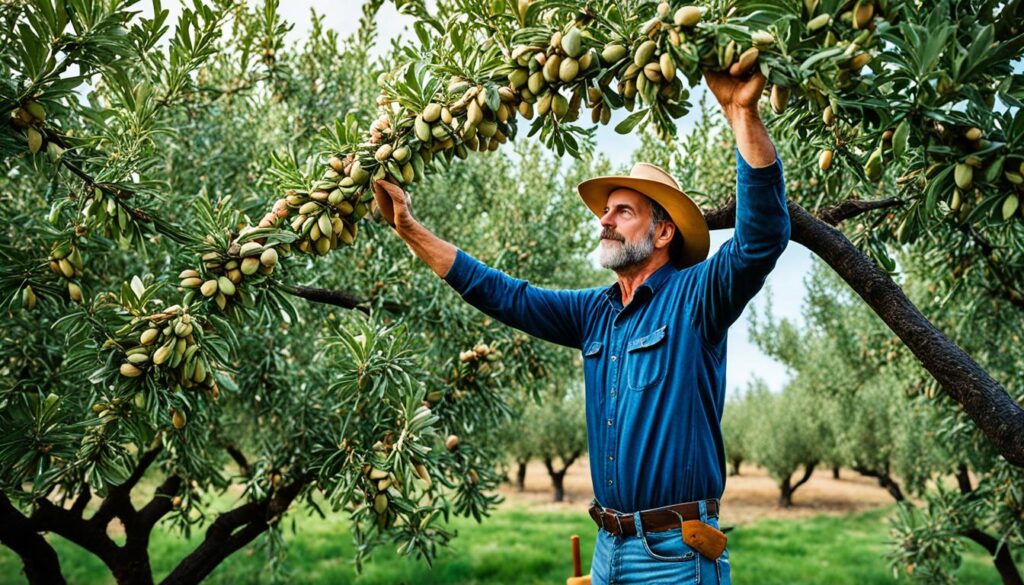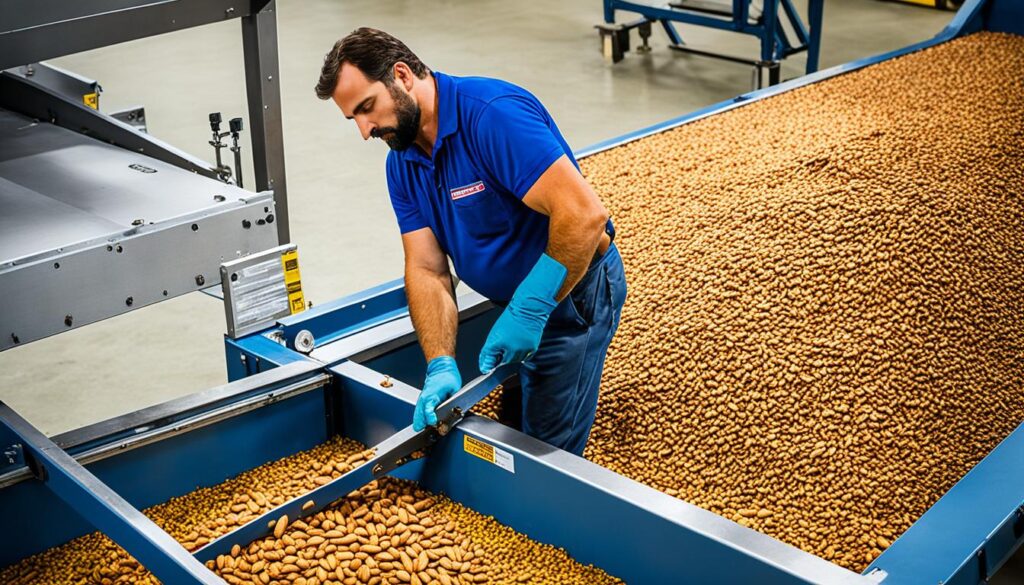
Have you ever thought about where your almonds come from? They start in lush orchards and end up in your meals. The journey of almonds from tree to your plate is full of hard work and special care. Let’s dive into the story of almond growers and what makes California a top spot for growing almonds.
The Almond Lifecycle: A Journey of Growth and Renewal
The almond tree’s lifecycle is a fascinating story of nature’s dance. It goes from the rest of winter to the lively bloom of spring. This journey shows how adaptable and strong this crop is.
Dormancy: Resting for the Next Harvest
When it’s cold, the almond tree takes a break and loses its leaves. It gets ready to save energy. This happens from November to January. Then, the tree gets the nutrients and water it needs. This quiet time is key for its health and the good harvest it will bring next year.
Bloom and Pollination: The Bees’ Vital Role
In February and March, the almond tree’s buds come alive with white and pink flowers. This isn’t just beautiful; it’s crucial for almonds to grow. Since most almond trees need bees to pollinate them, beekeepers bring their hives. This helps the trees make almonds. It’s a perfect teamwork between the trees and the bees.
The almond tree’s lifecycle showcases the beauty of nature. It starts from the cold of winter and bursts into life with spring blooms. This cycle fascinates farmers, scientists, and people who enjoy almonds. Understanding the almond tree’s journey shows how amazing and adaptable it is as a food source.
Almond Orchards: Where the Magic Happens
In California’s Central Valley, almond orchards thrive. They are the heart of the state’s almond success. These vast areas are filled with millions of almond trees. They reflect the hard work and care of farmers.
Responsible Farming and Water Conservation
Almonds are a favorite nut that need a lot of water. In California, where droughts are common, water is precious. Yet, almond farmers use the latest techniques to use water wisely.
The Gardiners at Gardiner Farms are a great example. They are third-generation almond growers known for their sustainable farming. They use high-tech irrigation and even feed almonds to their cattle. These methods help their orchards stay healthy while protecting the environment.
Bees are also vital for almond tree pollination. Farmers take special care of them to ensure good harvests. They provide a safe place and plenty of food for bees.
Farmers like the Gardiners are leading the way in sustainable farming. Almonds are in high demand worldwide. Their responsible methods help meet this demand without harming the planet.
| Key Sustainable Farming Practices | Benefits |
|---|---|
| Ultra-efficient irrigation systems | Reduced water usage and improved water conservation |
| Repurposing almond hulls for cattle feed | Minimizing waste and creating a circular economy |
| Utilization of almond shells as fuel | Sustainable energy source and waste reduction |
| Beekeeping integration for pollination | Supporting healthy bee populations and ensuring almond tree productivity |
Harvesting Almonds: From Tree to Ground
Almonds are a top product in California. They go through a detailed harvesting process. This turns the nuts from trees into the snacks we enjoy. Each autumn, under the bright sun, almonds get ready for harvest. This season is a mix of nature and technology working together.
The main almond harvest time is August to October, with a focus in the summer. Mechanical shakers rattle the trees, dropping the almonds. They fall with their shells still on. Then, they dry in the sun for up to ten days. This helps them get ready for the next step.
After drying out, machines tidy up the almond rows. This makes room for pickup. A special harvester then collects the almonds. It sorts them by type, keeping their unique tastes and shapes apart.
The whole harvesting process, from shaking to picking up, happens more than once in the orchards. This ensures all almonds are gathered when they are the best.
| Almond Harvesting Milestones | Timing |
|---|---|
| Almond Shaking | August – October |
| Almond Drying | 7 – 10 days |
| Almond Sweeping | After drying period |
| Almond Pickup | 2 – 3 times per orchard |
Over two million tons of almonds are grown each year globally. Most come from California, making almonds its third-biggest crop. This detailed harvest ensures we get to enjoy healthy and tasty almonds worldwide.

almonds from tree: Processing and Quality Assurance
After harvest, almonds begin their careful processing journey. This ensures top-notch quality and uniformity. The process includes hulling, shelling, sorting, and grading. These steps make raw almonds into the great products we all enjoy.
Hulling, Shelling, and Sorting
At the huller/sheller facility, almonds lose their outer coverings. Laser tech and manual checks then sort them, removing defects. This keeps the almonds perfect.
Advanced equipment then cuts or processes the almonds. They can become toppings, ingredients, flour, or butter.
Grading and Packaging for Global Distribution
Next, almonds are graded to USDA standards for size and quality. After this, they are carefully packed for shipping worldwide. Packaging can be in large cartons or fiber bins, all kept cold.
The industry values quality, seen in its certifications. Almonds are SQF-certified, non-GMO, Kosher, and Halal. This meets diverse market needs for quality, diet, and religion.
With California’s almonds reaching over 100 countries, it stays at the top. Advanced tech, eco-friendly farming, and strict quality checks promise only the best almonds.

Sustainable Coproducts: A Zero-Waste Approach
Being an almond grower means you work towards a zero-waste goal. You aim to use every part of the almond tree and crop, adding value where you can. This way, the almond industry in California finds new uses for almond coproducts like shells and hulls.
Shells now help as bedding for livestock. And hulls are given to dairy animals. Yet, the industry is also looking at creative ways to use these parts. They want to use them in making stronger plastics, sustainable fuels, and even in brewing beer.
The almond industry also teams up with the University of California, Davis. These partnerships lead to new tech and ideas. The main aim is to turn almond coproducts into sought-after products themselves. This supports a circular economy, where everything is used and reused.



